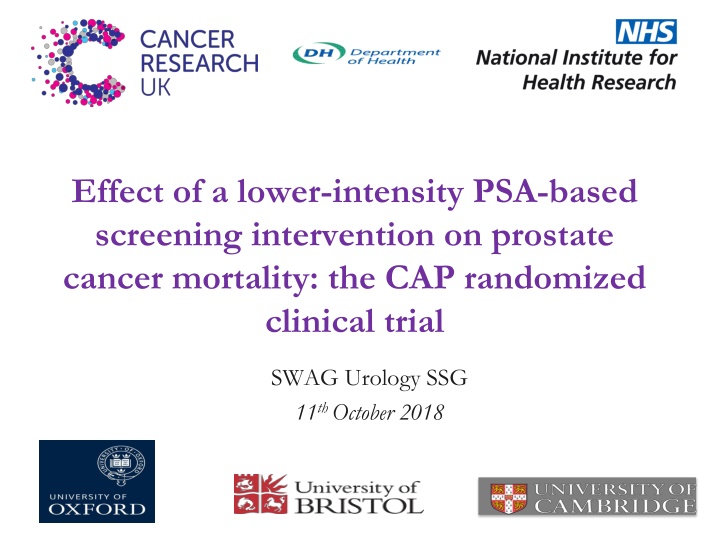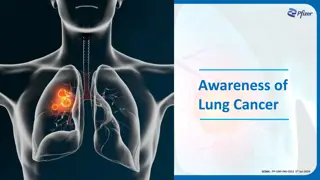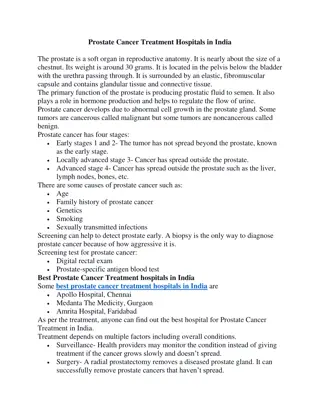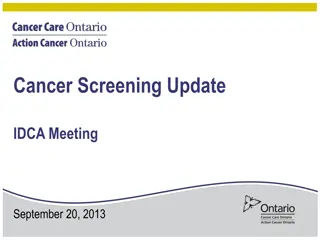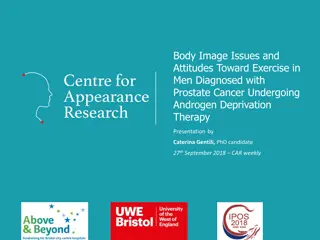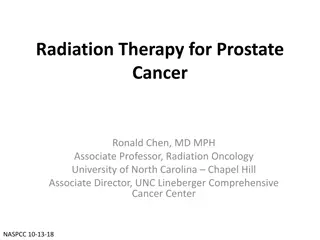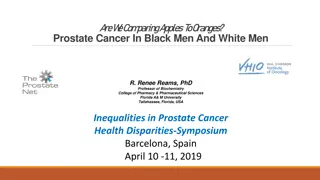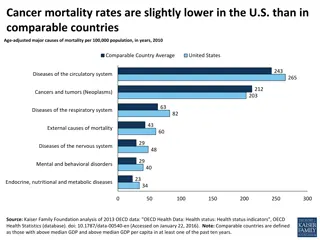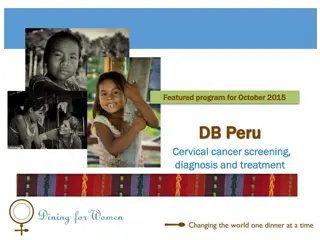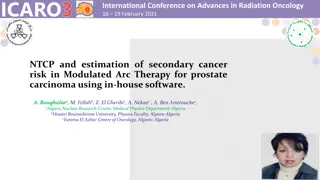Effect of Lower-Intensity PSA-Based Screening on Prostate Cancer Mortality
The CAP randomized clinical trial explores the impact of a lower-intensity PSA-based screening intervention on prostate cancer mortality. Context from ERSPC, PLCO, and ProtecT studies is provided, highlighting the balance of benefits and harms in men. Objectives include estimating the effect of a single PSA screen invitation on PCa-specific mortality, all-cause mortality, PCa detection, and more. The study conducted in UK General Practices analyzed outcomes over a 10-year period. Power analysis was performed to detect a specific mortality rate ratio. Results and implications may have significant implications for prostate cancer screening practices.
Download Presentation

Please find below an Image/Link to download the presentation.
The content on the website is provided AS IS for your information and personal use only. It may not be sold, licensed, or shared on other websites without obtaining consent from the author.If you encounter any issues during the download, it is possible that the publisher has removed the file from their server.
You are allowed to download the files provided on this website for personal or commercial use, subject to the condition that they are used lawfully. All files are the property of their respective owners.
The content on the website is provided AS IS for your information and personal use only. It may not be sold, licensed, or shared on other websites without obtaining consent from the author.
E N D
Presentation Transcript
Effect of a lower-intensity PSA-based screening intervention on prostate cancer mortality: the CAP randomized clinical trial SWAG Urology SSG 11th October 2018
Context of PSA based screening ERSPC and PLCO highlighted that the balance of benefits and harms in men remains close Small mortality benefit with 2-4 yearly repeated screening, 5 instead of 6 deaths in 1000 Overdiagnosis between 20-50%, increasing with the intensity of screening Men receiving surgery or radiotherapy experience serious impacts on sexual, urinary & bowel function - clearly quantified in ProtecT
Objectives Estimate the effect of an invitation to a single PSA- screen (vs standard practice) on median 10-yr: - PCa-specific mortality (1ary outcome) - All-cause mortality (2ary outcome) - PCa detection, stage & grade (2ary outcomes) Other 2ary outcomes not reported here: PCa & all- cause mortality at 15 yrs, HRQoL, cost-effectiveness
CAP (2001-2009, Zelen design) UK General Practices (N=573/785; 73%) Invited to PSA testing intervention (ProtecT study) N=189,386 Comparison arm N=219,439
CAP (2001-2009, Zelen design) UK General Practices (N=573/785; 73%) Invited to PSA testing intervention (ProtecT study) N=189,386 Comparison arm N=219,439 Attended 75,707(40%) (PSA>3ng/ml: 10-core biopsy DNA 113,679 ProtecT randomization to 3 treatments Standard NHS management
CAP (2001-2009, Zelen design) UK General Practices (N=573/785; 73%) Invited to PSA testing intervention (ProtecT study) N=189,386 Comparison arm N=219,439 All eligible men flagged Attended 75,707(40%) (PSA>3ng/ml: 10-core biopsy DNA 113,679 ProtecT randomization to 3 treatments Standard NHS management Standard NHS management Primary outcome prostate cancer mortality 10 years (reached March 2016) analysed by intention-to-screen Power to detect an overall PCa mortality rate ratio (ORR) of 0.84, 80% power (5% alpha)
Post-randomization exclusions did not introduce selection bias No important differences in: Characteristics of randomised practices that did vs did not agree to participate Characteristics of intervention vs control- group practices or men The distribution of non PCa deaths between intervention vs control-group
Adherence Of 189,386 intervention group men: 75,707 (40%) attended for PSA-testing 67,313 (36%) had a blood sample taken 64,436 had a valid test result Of these 64,436 men: 6,857 (11%) - PSA 3-19.9ng/ml (ProtecT eligible ) Of whom 5,850 (85%) had a prostate biopsy Cumulative PSA testing in controls indirectly estimated at 10-15% over 10-years
Effect of CAP PSA invitation intervention on 10 yr median PCa mortality PCa deaths Intervention arm: n = 549 (0.30/1000 pyrs) Control arm: n = 647 (0.31/1000 pyrs) Rate ratio, ITT 0.96 (95% CI: 0.85, 1.08); p=0.50 Rate difference per 1000 person years - 0.013 (95% CI: - 0.047, 0.022)
Kaplan Meier cumulative PCa mortality Median (IQR) follow-up: Int: 10.03 (8.80, 11.50) Control: 9.92 (8.74, 10.93) Non-proportional hazards: p=0.38
Effect of the CAP PSA invitation intervention on cumulative PCa risk Incident PCa Intervention: n=8,054 (4.3%) Control: n = 7,853 (3.6%) Detection per 1000 pyrs: 4.45 (95% CI: 4.36, 4.55) vs. 3.80 (3.72, 3.89) Difference per 1000 pyrs 0.65 (0.52, 0.78; p<0.001) During screening phase 10.42 v 2.18 (p<0.001)
Cumulative incidence by stage & grade PCa in the intervention-group more likely to be low-grade & early-stage (p<0.001)
Other secondary/subgroup analysis IV analysis (causal effect amongst attenders) 0.93 (95% CI 0.67, 1.29); p=0.66 All cause mortality: Intervention arm: n = 25,459 (13.7/1000 pyrs) Control arm: n = 28,306 (13.5/1000 pyrs) RR: 0.99: 95% CI 0.94, 1.03; p=0.49 No differences in effect by age or SES Intervention-related deaths 8 in the intervention-group, 7 in controls
Missed lethal cancers in the intervention-group Of 549 men who died in the intervention-group Attended a screening appointment: 188 (34%) Of the 188 attendees who died, 129 (69%) had not been identified by a PSA test: Not received a PSA test: n = 42 Eligible men not receiving a biopsy: n = 15 PSA level < 3ng/ml: n = 68 Benign prostate biopsy result: n = 4
Limitations Single screen - multiple rounds in ERSPC & PLCO But over-detection with repeat screens Lower-intensity strategy under-detected lethal cases High intensity wrt TRUS biopsy: 85% adherence; 10-core Identification of this is a design strength 40% adherence vs 59-69% in ERSPC IV analysis (effect of attendance) found similar results mpMRI will improve diagnostic pathway Median 10-yr follow-up may be too short In ProtecT, PCa mortality was 1% across treatments If lower-intensity strategy with TRUS biopsy has a long- term effect, would still be informative for mpMRI
At a median 10 yrs, a lower-intensity screening intervention (a single PSA test): Had no discernible effect on PCa-specific mortality Increased detection of early-stage, low-grade PCa Did not detect some lethal cancers Long-term follow-up will ascertain if lower-intensity screening reduces over-detection while achieving mortality gains The current findings do not support single PSA- testing for population-based screening
Dissemination www.youtube.com/channel/UCc0AUjDL7q 89p3IGyIigB0g https://discover.dc.nihr.ac.uk/content/signal -000602/single-routine-offer-of-a-blood-test- for-prostate-cancer-did-not-save-lives CLAHRCBite
Further funded work Effect on 15-year PCa-specific & all-cause mortality Age-specific lead time & over-diagnosis rates Projected lifetime effectiveness & cost-effectiveness of alternative, UK-focused PCa screening options UK-specific decision analytic (Markov) model Incorporate parameters computed from CAP & ProtecT MPES to enable assessment of risk stratified screening & use of mpMRI
Acknowledgements International Trial Steering Committee (TSC): Michael Baum (chair), Peter Albertsen, Tracy Roberts, Mary Robinson, Jan Adolfsson, David Dearnley, Anthony Zeitman, Fritz Schroder, Tim Peters, Peter Holding, Teresa Lennon, Sue Bonnington, Malcolm Mason, Jon Oxley. Data Monitoring Committee (DMC): Lars Holmberg (chair), Rob Pickard, Simon Thompson, Usha Menon. Cause of Death Evaluation (CoDE) committee: Peter Albertsen (chair), Colette Reid, Jon McFarlane, Jon Oxley, Mary Robinson, Jan Adolfsson, Michael Baum, Anthony Zeitman, Amit Bahl, Anthony Koupparis. Trial Management Group (TMG): Lead PI (Prof Martin) and co-PIs (Profs Donovan, Hamdy and Neal). Dr Turner trial co-ordinator. Dr Lane, ProtecT trial co-ordinator, Prof Sterne and Dr Metcalfe statistical input. Dr Noble health economic analyses. Drs Mohiuddin and Sanghera decision-analytical model-based economic evaluation. Prof Ben-Shlomo (epidemiology); Dr Oliver (public health), Dr Brindle (public health), Simon Evans (urologist) Research Staff (past & present): Fieldworkers: Lindsey Bell, Leah Bowen, Vicky Brookes, Charlotte Davies, Sean Harrison, Liz Hill, Laura Hughes, Mari-Anne Rowlands, Liz Salter, Jainnee Mauree, Siaw Yein Ng, Naomi Williams; Kerry Avery (recruitment) Data Management: Liz Down, Eleanor Walsh; Michael Davies; Database development: Pete Shiarly; Statistician: Grace Young; Health Economics: Joanna Thorn; Research support: Marta Tazewell, Jessica Toole; Administrators: Genevieve Hatton-Brown, Chris Pawsey, Tom Steuart-Feilding; Mr Luke Hounsome (National Cancer Registration & Analysis Service, Public Health England). ProtecT Research, Nursing & Administrative staff
Comparison of RCTs CAP ERSPC PLCO Mean age (yrs) N controls % PSA-tested, intervention 59.0 219,439 36% 61.5 89,353 64% NA 38,350 85% 41%8 Biopsy rate 85% 86% PSA testing in controls 10% over 10 yrs 15% 50% 5% over 9 yrs6 PCa risk, intervention 4% over 10 yrs 8% over 10 yrs PCa s in controls Gleason grade 6 Gleason grade 7 Gleason grade 8 Stage T1/2 PCa s in intervention grp Gleason grade 6 Gleason grade 7 Gleason grade 8 Stage T1/2 Mean age at diagnosis (yrs) 35% 41% 24% 60% 55% 29% 16% 79% 62% 27% 12% 95% 45% 37% 18% 69% 67 72% 20% 7% 90% 61 67% 24% 9% 97% NK
